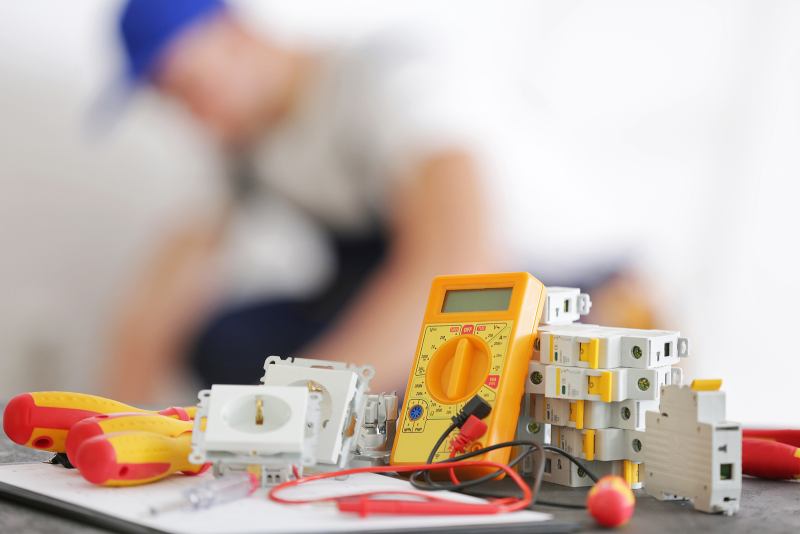24-Hour Emergency Electricians in Fort Worth, TX
Call this Thursday to Get 10% OFF
Need an electrician?
Schedule NowRequest Electrical Service Now
817-585-299324-Hour Emergency Electricians in Fort Worth, TX
Call this Thursday to Get 10% OFF
Need an electrician?
Schedule NowRequest Electrical Service Now
817-585-2993
You may have seen a friend or family member with a strange looking device called a Multimeter. Many home and business owners have one on hand to help with electricity related issues. For some, these little boxes with protruding wires can seem very intimidating, and a lot of individuals never invest in one because they aren’t sure what they’re for. The truth is, this affordable tool can be extremely helpful and the team at Mr. Electric of Fort Worth enjoys helping our local clients find ways to take care of their electrical system. Here are a few tips for how to use a Multimeter for your own North Texas household.
A multimeter is a portable handheld instrument used for detecting voltage, resistance and amperage in wires, fuses, batteries and transistors. There are two varieties of multimeters available, analog and digital. An analog multimeter will have a needle that moves back and forth between a scale. They are less expensive than digital units, and are more sensitive, which makes it easier to detect slow or subtle changes in voltage. However, they are less accurate and can be more challenging for beginners to read accurately. A digital multimeter is the most common variety in use today. Rather than using a needle and scale, an LCD screen displays the information needed. Prices and features can vary widely, from affordable basic units to the expensive professional models used by engineers and electricians. However, for every day home use, a basic digital multimeter should be all you need.
Whether you choose an analog or digital multimeter, their function is still the same. Common tasks include testing batteries, checking the effectiveness of a broken extension cord, or inspecting an appliance. On every multimeter, you will find two tester leads, a red and black wire. The black lead will plug into the “common” port, and the red lead will plug into either one of the other two ports, depending on your needs.
- Battery Testing – This is the most basic way to use your multimeter and battery testing, and is an excellent way to try out your skills for the first time. This sort of test will be used to detect the direct current or (DC) voltage of the battery. Place your scale range setting to 12 volts, and touch the test probes to the equivalent polarity as the battery. The positive with positive, and negative with negative. A good reading should be within 20 percent of its original voltage rating. If it falls below this number, then the battery probably needs to be replaced.
- Determining the Quality of a Broken Extension Cord – The next level up would be determining the electrical capabilities of a damaged extension cord. For this exercise, you’ll be testing the Ohms. Change the scale range setting to “auto-ranging”. The safest and most efficient way to test cords is to use a fluke clamp meter. These devices work the same as a traditional multimeter, but there’s a spring-loaded clamp on the end, where you can place around wires. Use a line splitter, and place the fluke clamp meter around each split line, to get an accurate reading.
Safety Tips
Be very careful when using your multimeter, particularly when high voltage is a factor. No matter what the circumstances, you should always assume that the circuit is energized. Be absolutely certain that your multimeter isn’t damaged in any way before using to avoid injury. Make sure you keep your multimeter and all its accessories safely stored between use to avoid damage. When your test probes are plugged into the jacks, the connection needs to be firm, not loose. Use protective equipment such as gloves, headwear and rubber mats that are specially designed for electrical work to reduce your chances of electrical shock, especially when handling exposed circuits greater than 50 V. Don’t work alone, always have backup in case an emergency occurs, and keep the area clear of any moisture, liquid or flammable items. If you don’t have professional training or experience working with higher voltage, it’s always best to get help from a qualified professional, and only use a basic multimeter for low voltage scenarios like those mentioned above.
Need Help from a Certified North Texas Electrician? Call Mr. Electric of Fort Worth
Do you need an electrical inspection, wiring repair or other professional service? The certified, licensed and insured electricians at Mr. Electric proudly provide residential and commercial services in Fort Worth, Mansfield, Benbrook, Burleson, Saginaw, White Settlement, Arlington, Lake Worth, Aledo and Weatherford, Texas. Call our office for more information or to schedule a convenient appointment.